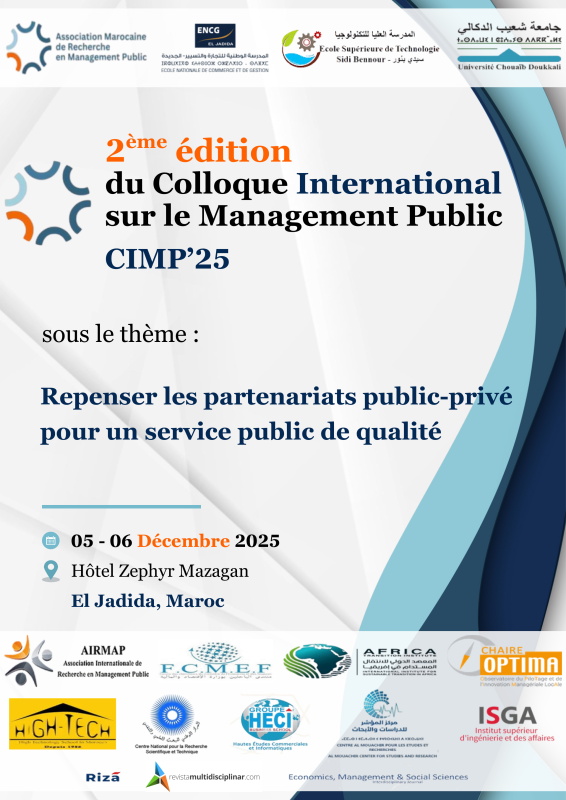Le gap fiscal au Maroc
une analyse économétrique de l’impact des facteurs socio-démographiques et fiscaux
DOI :
https://doi.org/10.23882/emss.24208Mots-clés :
gap fiscal, évasion fiscale, évitement fiscal, facteurs socio-démographiques, variables fiscalesRésumé
Cette étude vise à appréhender l'impact des variables non économiques sur le gap fiscal au Maroc, à savoir les facteurs sociodémographiques et les facteurs fiscaux (changements réglementaires). L'analyse est menée sur la période 1980-2018 et inclut des variables de contrôle économiques. Pour ce faire, nous estimons un modèle log-linéaire en utilisant la méthode des moindres carrés modifiés.
Les résultats mettent en lumière l'effet des variables sociodémographiques sur l'évolution du gap fiscal au Maroc : l'âge semble refléter l'effet de l'expérience dans le contournement de l'impôt. Le genre et l'éducation ne semblent pas avoir d'effet sur le gap fiscal au Maroc. L'effet des variables de contrôle économiques semble clair : les revenus/bénéfices générés dans le secteur du commerce semblent faire l'objet d’évasion et d’évitement fiscaux et augmentent, par conséquent, le gap fiscal au Maroc, par rapport aux revenus générés par d'autres secteurs.
Les facteurs fiscaux ont été introduits dans nos estimations par le biais de variables muettes. Ils nous ont permis de conclure que les agents économiques sont plus sensibles aux mesures et réglementations fiscales indirectes, plutôt qu'aux mesures directes visant à réduire le gap fiscal.
Références
Allingham, Michael G., & Sandmo, A. (1972). “Income Tax Evasion: A Theoretical Analy- sis.” Journal of Public Economics 1 No. ¾, pages 323-38.
Arby, M. F., Malik, M. J., & Hanif, M. N. (2012). “The size of informal economy in Pakistan”, Finance Research, 1(2), pages 11-18.
Bühn, A., & Schneider, F. (2008). « MIMIC Models, Cointegration and Error Correction: An Application to the French Shadow Economy», CESIFO Working Paper N° 2200, Category: Public Finance.
Cagan, P. (1958). “The Demand for Currency Relative to Total Money Supply”, National Bureau of Economic Research, New York, Occasional Paper 62.
Christian, C. W., & Gupta, S. (1993). “New evidence on ‘secondary evasion’”, Journal of the American Taxation Association, 16, pp: 72–93.
Clotfelter, C. T. (1983). “Tax Evasion and Tax Rates: An Analysis of Individual Returns”. The Review of Economics and Statistics, The MIT Press, 65(3), 363-373.
Dell’Anno, R., & Solomon, O. H. (2008). « Shadow Economy and Unemployment Rate in USA: Is there a Structural Relationship? An Empirical Analysis », Applied Economics, 40(19), 2537-2555.
Dubin, J., & Wilde, L. (1988). “An Empirical Analysis of Federal Income Tax Auditing and Compliance”. National Tax Journal, 1988, 41(1), 61-74.
El Aida, K., & Fettahi, I. (2018). « Estimation de la taille de l’économie non observée au Maroc et analyse de son évolution : utilisation de la méthode de demande de monnaie », article non publié.
Engle, R. F., & Granger, C. W. J. (1987). « Co-integration and error correction: representation, estimation, and testing», Econometrica: Journal of the Econometric Society, 55(2), 251-276.
Feige, E. L. (1979). « How big is the irregular economy? », Challenge, 22(5), 5-13.
Feinstein, J. S. (1991). “An econometric analysis of income tax evasion and its detection”, RAND Journal of Economics, 22, 14–35.
Feld, L., &Schneider, F. (2010). « Survey on the Shadow Economy and Undeclared Earnings in OECD Countries », German Economic Review, 11(2), 109-149.
Guttman, P. M. (1977). « The subterranean economy », Financial Analysts Journal, 33(6), 26-27.
Hanno, D. M., & Violette, G. R. (1996). “An analysis of moral and social influences on tax behavior”, Behavioral Research in Accounting, 8, 57–75.
Jackson, B. R., & Milliron, V. C. (1986). “Tax compliance research: Findings, problems and prospects”, Journal of Accounting Literature, 5, 125–165.
Kelley, B. (1994). « The Informal Sector and the Macroeconomy: A Computable General Equilibrium Approach for Peru », World Development, 22(9), 1393-1411.
Mason, R., & Calvin, L. (1984). “Public confidence and admitted tax evasion” National Tax Journal, 37(4), 489-496.
Mason, R., & Lowry, H. (1981). “An estimate of income tax evasion in Oregon”, Working Paper, Corvallis, Oregon: Survey Research Center, Oregon State University.
Mason, R., &Calvin, L. (1978). “A study of admitted income tax evasion”, Law and Society Review, 12, 73–89.
Murray, M. P. (1994). « A Drunk and Her Dog : An Illustration of Cointegration and Error Correction», The American Statistician, 48(1), 37-39.
Phillips, P. C. (1992). « Hyper-consistent Estimation of a Unit Root in a Time Series Regression ». Cowles Foundation for Research in Economics at Yale University, Discussion Paper N°1040.
Phillips, P. C. (1995). « Fully modified least squares and vector autoregression », 63(5), Econometrica: Journal of the Econometric Society, 1023-1078.
Phillips, P. C., & Hansen, B. E. (1990). « Statistical inference in instrumental variables regression with I (1) processes. » The Review of Economic Studies, 57(1), 99-125.
Richardson G. (2006)- “Determinants of tax evasion: A cross-country investigation”, Journal of International Accounting, Auditing and Taxation, 15, 150–169.
Richardson, M., & Sawyer, A. J. (2001). “A taxonomy of the tax compliance literature: Further findings, problems and prospects”, Australian Tax Forum, 16, 137–320.
Sandmo, A. (2005). « The Theory of Tax Evasion: A Retrospective View », National Tax Journal, 58(4), 643-663
Schmolders, G. (1970). “Survey research in public finance: A behavioral approach to fiscal theory”, Public Finance, 25, 300–306.
Schneider, F., Buehn, A., & Montenegro, C. E. (2010). « Shadow Economies all over the World: New Estimates for 162 Countries from 1999 to 2007 », World Bank Policy Research Working Paper Series, WP S5356.
Song, Y. D., & Yarbrough, T. E. (1978). “Tax ethics and tax attitudes: A survey”, Public Administration Review, 38, 442–452
Tanzi, V. (1980). « The Underground Economy in United States–Estimates and Implications », BancaNazionale de Lavoro Quarterly Review, 135, 427-453.
Tanzi, V. (1983). « The Underground Economy in the United States: Annual Estimates, 1930-80», Staff Papers-International Monetary Fund, 30(2), 283-305.
Tittle, C. (1980). “Sanctions and social deviance: The question of deterrence”, New York: Praeger.
Vogel, J. (1974). “Taxation and public opinion in Sweden: An interpretation of recent survey data”, National Tax Journal, 27, 499–513.
Wallschutzky, I. G. (1984). “Possible causes of tax evasion”, Journal of Economic Psychology, 5, 371–384.
Warren, N. (2018). “Estimating Tax Gap is everything to an informed response to the Digital Era”, Working paper, UNSW Business School Taxation and Business Law, Australia’s Global University.
Witte, A. D., & Woodbury, D. F. (1985). “The effect of tax laws and tax administration on tax compliance: The case of the U.S. individual income tax”, National Tax Journal, 38, 1–13.
Téléchargements
Publiée
Comment citer
Numéro
Rubrique
Licence
(c) Tous droits réservés El Aida Kawtar, Fettahi Ithri 2024

Ce travail est disponible sous licence Creative Commons Attribution - Pas d’Utilisation Commerciale 4.0 International.







